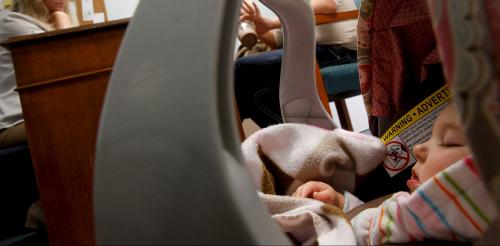This article originally appeared in The Hill on September 7, 2018.
 The issue of paid family and medical leave is getting more attention and for good reason. Since middle class status often requires two full time incomes, families are increasingly struggling with work life balance. Children do better when parents can leave work temporarily to care for them, though many cannot afford to do this. Paid leave also promotes labor force attachment, especially for women, which is vital for economic growth. The proportion of working women in the United States has fallen behind that of other countries, partially due to a lack of paid leave. The critical challenge of providing paid leave is balancing the generosity of benefits provided and the costs imposed on employers, employees, and the federal coffer. A diverse group of academics, policy thinkers, and economists from across the ideological spectrum recently came together under the umbrella of the American Enterprise Institute and Brookings Institution working group on paid leave to dissect this issue. We had the privilege of leading these experts, who sought to find common ground. Paid family and medical leave includes three main types of leave. There is parental leave to care for a newborn or newly adopted child, medical leave to care for personal illness, and family care leave to care for a seriously ill family member. A recent poll shows 84 percent of Americans support a comprehensive national paid leave policy. Across the political spectrum, we have 94 percent of Democrats, 83 percent of Independents, and 74 percent of Republicans in favor of paid leave. Several federal and state policies have addressed this issue. The Family and Medical Leave Act gives workers 12 weeks of unpaid leave. As part of the Tax Cuts and Jobs Act, employers can claim tax credits for voluntarily offering at least two weeks of paid leave to their employees. Seven states and the District of Columbia have passed paid leave laws. Many private sector employers are now offering paid leave policies to their employees. About 13 percent of private sector workers are covered for parental and family care leave, while a larger fraction have access to medical leave. Yet, these benefits are often concentrated at the top, as lower wage workers are least likely to have access to any type of paid leave. Two prominent proposals in Congress seek to expand paid leave access for Americans. Senator Marco Rubio (R-Fla.) introduced a bill to allow families to claim Social Security benefits early, at the cost of delayed receipt of retirement benefits. Another bill, the Family and Medical Insurance Leave Act, introduced by Senator Kirsten Gillibrand (D-N.Y.) and Representative Rosa DeLauro (D-Conn.), builds on the Family and Medical Leave Act by funding paid leave through higher payroll taxes. Although conservatives and liberals both agree that having access to paid leave confers several benefits on working families, such as improved labor force participation and better health outcomes for children and mothers, they have debated the costs, flexibility for states and employers, and potential work disincentives or misuse of benefits. Each side brings important points to the policy debate on paid leave. That debate is one focus of the new report from our working group. After lengthy discussions, members agreed that a national paid parental leave program was needed. Different members favored different durations of paid parental leave, mostly ranging from six weeks to 12 weeks or more, but we endorsed a compromise of eight weeks of paid parental leave at 70 percent of wages with a maximum benefit of $600 a week. As for paid leave for medical or family care purposes, many members wanted to bundle all three types of leave together and fund this by adding to the payroll taxes paid by employees. Other members were unsure about the benefits of paid medical or family care leave relative to their costs and questioned the need for a new federal policy. The current medical leave system necessitates that employers provide leave for very short term illnesses, through either paid sick days or short term disability insurance. Moreover, there are public benefits in the form of Social Security disability insurance for those certified permanently unable to work. This system fails to cover many people who face a serious illness, such as cancer or a broken leg, that is not permanently disabling but also likely to exhaust any sick leave they may have accumulated. Therefore, many in our group believed more thought should be given to a new national temporary disability policy that would bridge the gap between paid leave for short term illness and longer term disability coverage. Further study would help address the cost and interaction with sick leave and Social Security disability insurance of this new program. Importantly, many believe the costs of a temporary program would be at least partially offset by reductions in Social Security disability insurance benefits. For family care leave, we all agreed that the ability to take leave to care for an ill family member is beneficial. However, there was no consensus around the idea of a paid federal program for this type of leave, with some arguing that the unmet need for this is minimal. A sticking point in discussions about paid leave is the actual cost of these policies. Our report sheds light on this by bringing together modelers from diverse organizations to help policymakers understand exactly why estimates associated with paid leave policies differ. Our report finds the costs of all three types of leave together vary from $17 billion to $46 billion. But consistent across all types of modeling is that medical leave is the most expensive and family care leave is the least expensive. While some may view our inability to come together on family care leave as disappointing, we believe our discussions will help us move forward. By identifying points of agreement and divergence and suggesting areas of further research, we are optimistic that we can help build an evidence based approach to all three types of leave. Our report was no small feat and took significant commitments of time and energy. These efforts by a diverse group of experts demonstrate the importance of this issue and the resolve that has emerged to find a solution that appeals to both the left and the right. Bringing conservative and liberal voices together in this conversation is the most feasible and desirable way to make paid family and medical leave a sustainable reality for America. We hope our work will help push the nation forward on this issue.
The issue of paid family and medical leave is getting more attention and for good reason. Since middle class status often requires two full time incomes, families are increasingly struggling with work life balance. Children do better when parents can leave work temporarily to care for them, though many cannot afford to do this. Paid leave also promotes labor force attachment, especially for women, which is vital for economic growth. The proportion of working women in the United States has fallen behind that of other countries, partially due to a lack of paid leave. The critical challenge of providing paid leave is balancing the generosity of benefits provided and the costs imposed on employers, employees, and the federal coffer. A diverse group of academics, policy thinkers, and economists from across the ideological spectrum recently came together under the umbrella of the American Enterprise Institute and Brookings Institution working group on paid leave to dissect this issue. We had the privilege of leading these experts, who sought to find common ground. Paid family and medical leave includes three main types of leave. There is parental leave to care for a newborn or newly adopted child, medical leave to care for personal illness, and family care leave to care for a seriously ill family member. A recent poll shows 84 percent of Americans support a comprehensive national paid leave policy. Across the political spectrum, we have 94 percent of Democrats, 83 percent of Independents, and 74 percent of Republicans in favor of paid leave. Several federal and state policies have addressed this issue. The Family and Medical Leave Act gives workers 12 weeks of unpaid leave. As part of the Tax Cuts and Jobs Act, employers can claim tax credits for voluntarily offering at least two weeks of paid leave to their employees. Seven states and the District of Columbia have passed paid leave laws. Many private sector employers are now offering paid leave policies to their employees. About 13 percent of private sector workers are covered for parental and family care leave, while a larger fraction have access to medical leave. Yet, these benefits are often concentrated at the top, as lower wage workers are least likely to have access to any type of paid leave. Two prominent proposals in Congress seek to expand paid leave access for Americans. Senator Marco Rubio (R-Fla.) introduced a bill to allow families to claim Social Security benefits early, at the cost of delayed receipt of retirement benefits. Another bill, the Family and Medical Insurance Leave Act, introduced by Senator Kirsten Gillibrand (D-N.Y.) and Representative Rosa DeLauro (D-Conn.), builds on the Family and Medical Leave Act by funding paid leave through higher payroll taxes. Although conservatives and liberals both agree that having access to paid leave confers several benefits on working families, such as improved labor force participation and better health outcomes for children and mothers, they have debated the costs, flexibility for states and employers, and potential work disincentives or misuse of benefits. Each side brings important points to the policy debate on paid leave. That debate is one focus of the new report from our working group. After lengthy discussions, members agreed that a national paid parental leave program was needed. Different members favored different durations of paid parental leave, mostly ranging from six weeks to 12 weeks or more, but we endorsed a compromise of eight weeks of paid parental leave at 70 percent of wages with a maximum benefit of $600 a week. As for paid leave for medical or family care purposes, many members wanted to bundle all three types of leave together and fund this by adding to the payroll taxes paid by employees. Other members were unsure about the benefits of paid medical or family care leave relative to their costs and questioned the need for a new federal policy. The current medical leave system necessitates that employers provide leave for very short term illnesses, through either paid sick days or short term disability insurance. Moreover, there are public benefits in the form of Social Security disability insurance for those certified permanently unable to work. This system fails to cover many people who face a serious illness, such as cancer or a broken leg, that is not permanently disabling but also likely to exhaust any sick leave they may have accumulated. Therefore, many in our group believed more thought should be given to a new national temporary disability policy that would bridge the gap between paid leave for short term illness and longer term disability coverage. Further study would help address the cost and interaction with sick leave and Social Security disability insurance of this new program. Importantly, many believe the costs of a temporary program would be at least partially offset by reductions in Social Security disability insurance benefits. For family care leave, we all agreed that the ability to take leave to care for an ill family member is beneficial. However, there was no consensus around the idea of a paid federal program for this type of leave, with some arguing that the unmet need for this is minimal. A sticking point in discussions about paid leave is the actual cost of these policies. Our report sheds light on this by bringing together modelers from diverse organizations to help policymakers understand exactly why estimates associated with paid leave policies differ. Our report finds the costs of all three types of leave together vary from $17 billion to $46 billion. But consistent across all types of modeling is that medical leave is the most expensive and family care leave is the least expensive. While some may view our inability to come together on family care leave as disappointing, we believe our discussions will help us move forward. By identifying points of agreement and divergence and suggesting areas of further research, we are optimistic that we can help build an evidence based approach to all three types of leave. Our report was no small feat and took significant commitments of time and energy. These efforts by a diverse group of experts demonstrate the importance of this issue and the resolve that has emerged to find a solution that appeals to both the left and the right. Bringing conservative and liberal voices together in this conversation is the most feasible and desirable way to make paid family and medical leave a sustainable reality for America. We hope our work will help push the nation forward on this issue.




Commentary
A path forward on paid family leave
September 10, 2018